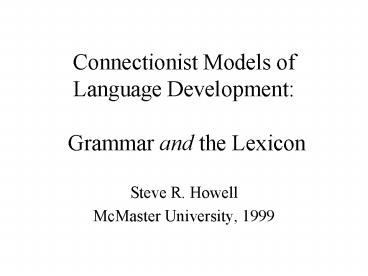Connectionist Models of Language Development: Grammar and the Lexicon - PowerPoint PPT Presentation
1 / 19
Title:
Connectionist Models of Language Development: Grammar and the Lexicon
Description:
Triples (Mozer, Wicklegren), or artificial phonemes ... completed simulation demonstrating superiority of triples or phoneme-level word ... – PowerPoint PPT presentation
Number of Views:95
Avg rating:3.0/5.0
Title: Connectionist Models of Language Development: Grammar and the Lexicon
1
Connectionist Models of Language Development
Grammar and the Lexicon
- Steve R. Howell
- McMaster University, 1999
2
Overview
- Description of Research Plan
- Explanation of Research Goals
- Examine Inspiration for this research, in both
connectionist and language sub-fields - Methods
- Results (Preliminary)
- Discussion Future Directions
3
Overall Research Plan
- Pursuit of an Integrated, multi-level,
connectionist model of language development - Multi-level dealing with several different
levels or parts of the language task - Integrated non-modular homogenous
functioning throughout the multi-level design
4
Research Goals
- Better understanding of language development
process - Ability to test different interventions on a
successful model, instead of children, including
possibly lesioning the model - Functional language-learning model for AI and
Software (e.g. Chatterbots on net)
5
Connectionist Inspiration
- Work of Jeff Elman on models of grammar learning
using Simple Recurrent Networks (SRNs) - Work of Landauer et. al. on acquisition of
semantic information (i.e. the lexicon) through
analysis of many weak word to word relations in
real-world text
6
Language-Domain Inspiration
- Evidence against a sharp divide in the
acquisition of the lexicon and grammar (e.g.
Bates) - Lexicon develops first, but grammar development
overlaps, in relation to it, and seemingly in
step with it) - Hence the present focus on homogenous mechanisms
to explain the two.
7
Method
- Computer Simulation of Connectionist (Neural
Network) model - Base algorithm and structure is Elmans (1990)
Simple Recurrent Network - Modifications include sub-word-level input,
multi-level architecture, and automated localist
to distributed representation conversion
8
Diagram of SRN
9
Parts of an Elman SRN
- Input Layer of Units
- Larger (usually) Hidden Layer of Units
- Context Layer memory connected to hidden layer
- Output Layer of units, same size as input layer
- Uses back-propagation learning algorithm
- Uses Prediction task to provide more plausible
teaching signal - Recurrent Context Units take copy of hidden units
at each time step
10
Modifications Sub-word Input
- Triples (Mozer, Wicklegren), or artificial
phonemes - Recently completed simulation demonstrating
superiority of triples or phoneme-level word
representations to whole-word localist
representations for grammar learning (phonics?)
11
Representations of Words
- Localist
- 0 0 0 0 0 0 0 1
- 0 0 0 1 0 0 0 0
- Binary Distributed
- 0 1 0 0 1 0 1 1
- 1 0 1 1 1 1 1 1
- Fully Distributed
- 0.43 0.23 0.03 0.1 0.04
- 0.22 0.12 0.04 0.42 0.5
- Elman(1990) - Localist
- Triples - Binary distrib.
- Semantic Encoding
- - Fully Distributed
12
Route to Multi-level Architecture
- Elman SRN showed how word co-occurrence
information could be used to learn word
relationships (simple grammar) - Learning was of previous words (context) to next
word predicted - Even with a sub-word distributed representation,
prediction is still of the next word
13
Elman (1990) Clustering Results
14
Sub-word prediction
- If we use a sliding window on the input text
(e.g. five letters for three letter triples) then
we are predicting the next triple from the
previous triples true sub-word prediction - e.g. The dog chased the cat...
- Time 1 - The_d The, he_, e_d, _d
- Time 2 - he_do he_, e_d, _do
15
Sub-word Advantages
- Richer representations, accessing more of the
data inherent in the text or speech stream - Makes prediction/internal representation easier
- Eliminates need for artificial pre-processing of
text into word vectors, just automatically
translates letters into triple vectors.
16
Sub-word Disadvantages
- Cannot output words easily, just have a
collection of triples - Must stack a clean-up net on top in order to
reach word representations from the existing
triple representations - Hence, the multi-layer approach combine
prediction at two time-scales and levels of
granularity, but using the same method
17
Multi-layer SRN Diagram
18
Multi-layer SRN
- Triples or letters layer
- Input Layer 1
- Hidden Layer 1
- Context Layer 1
- Output Layer 1
- Learns to predict triples/phonemes
- Word Layer
- Input Layer 2 Hidden Layer 1
- Hidden Layer 2
- Context Layer 2
- Output Layer 2
- Predicts words from triples/phonemes
19
(No Transcript)

